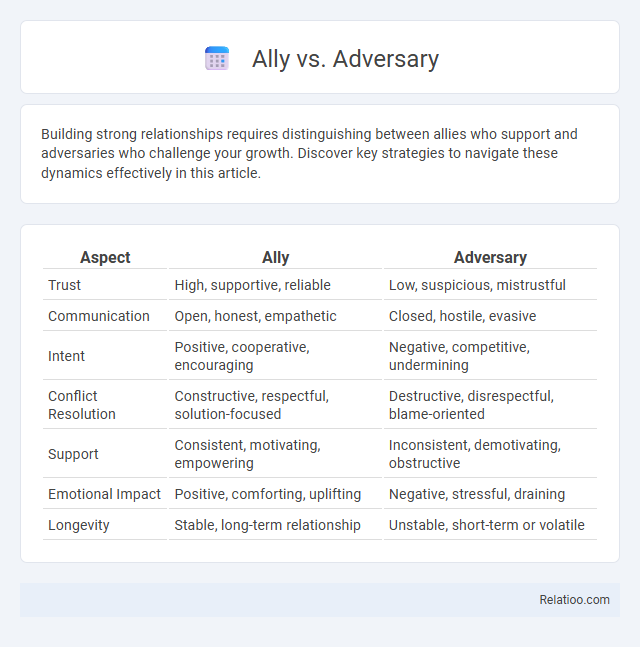Building strong relationships requires distinguishing between allies who support and adversaries who challenge your growth. Discover key strategies to navigate these dynamics effectively in this article.
Table of Comparison
| Aspect | Ally | Adversary |
|---|---|---|
| Trust | High, supportive, reliable | Low, suspicious, mistrustful |
| Communication | Open, honest, empathetic | Closed, hostile, evasive |
| Intent | Positive, cooperative, encouraging | Negative, competitive, undermining |
| Conflict Resolution | Constructive, respectful, solution-focused | Destructive, disrespectful, blame-oriented |
| Support | Consistent, motivating, empowering | Inconsistent, demotivating, obstructive |
| Emotional Impact | Positive, comforting, uplifting | Negative, stressful, draining |
| Longevity | Stable, long-term relationship | Unstable, short-term or volatile |
Understanding the Concepts: Ally vs Adversary
An ally is a person or entity that supports and cooperates with you toward common goals, fostering trust and collaboration. An adversary, in contrast, opposes your interests, creating conflict or competition that challenges your objectives. Understanding these distinctions helps you navigate relationships and strategize effectively in both personal and professional contexts.
Key Characteristics of Allies
Allies are characterized by mutual trust, shared goals, and cooperative behavior, providing reliable support and collaboration in achieving common objectives. They actively contribute resources, expertise, and encouragement to strengthen partnerships and foster long-term relationships. Your strategic advantage increases significantly when you cultivate strong allies who enhance resilience and collective problem-solving.
Identifying Traits of an Adversary
An adversary is characterized by opposition and active resistance to one's goals, often involving direct conflict or competition with intent to undermine or defeat. Unlike allies who support and rivals who compete respectfully, adversaries exhibit hostility, strategic maneuvering, and a desire to weaken the opponent's position. Key traits include antagonism, persistent challenge, and a lack of trust or cooperation.
The Importance of Recognizing Allies
Recognizing allies in any competitive or conflict situation is crucial for strategic advantage, as allies provide support, resources, and shared goals that enhance the chances of success. Unlike adversaries, who are direct opponents seeking harm or defeat, and rivals, who compete for similar objectives but may still engage in respectful competition, allies contribute positively by fostering cooperation and mutual benefit. Properly identifying and nurturing these alliance relationships strengthens trust, increases collective resilience, and enables more effective responses to challenges.
Signs That Someone is an Adversary
Signs that someone is an adversary include consistent opposition to your goals, lack of cooperation, and deliberate attempts to undermine your efforts. An adversary often engages in passive-aggressive behavior, spreads negativity, or works behind the scenes to hinder your progress. Recognizing these patterns helps you differentiate an adversary from a rival or ally, allowing you to strategically manage your relationships.
How to Build Strong Alliances
Building strong alliances involves fostering trust, clear communication, and mutual benefits between parties, distinguishing allies from adversaries and rivals by shared goals and collaboration. Establishing consistent, transparent interactions and aligning strategic interests ensures resilience and loyalty within alliances against adversarial challenges. Leveraging complementary strengths and maintaining open dialogue solidify partnerships, transforming potential rivals into cooperative allies for long-term success.
Strategies for Handling Adversaries
Handling adversaries requires clear strategies emphasizing de-escalation, boundary-setting, and consistent communication to prevent conflicts from escalating. Recognizing the distinct intentions and behaviors of adversaries compared to allies or rivals allows you to tailor your approach, maintaining professionalism and focus on long-term goals. Effective management includes assessing threats objectively and seeking resolution methods that minimize harm while asserting your interests.
Allies and Adversaries in the Workplace
Allies in the workplace foster collaboration, trust, and mutual support, enhancing team productivity and morale through shared goals and open communication. Adversaries create conflict and competition, often hindering progress by opposing ideas and challenging authority, which can lead to a toxic work environment. Understanding the dynamics between allies and adversaries helps organizations implement strategies that promote cooperation while managing conflicts effectively.
The Impact of Allies and Adversaries on Success
Allies provide strategic support, resources, and collaboration opportunities that enhance your chances of success by complementing your strengths and compensating for weaknesses. Adversaries, on the other hand, challenge your progress by creating obstacles and pushing you to innovate and adapt, which can ultimately drive growth and resilience. Understanding and managing the dynamics between allies and adversaries allows you to leverage relationships effectively, turning competition into motivation and cooperation into competitive advantage.
Transforming Adversaries into Allies
Transforming adversaries into allies requires strategic communication that addresses underlying conflicts and builds trust through empathy and mutual goals. Recognizing the differences between adversaries--who actively oppose you--and rivals--who compete without deep hostility--allows your approach to be tailored for collaboration rather than confrontation. By focusing on common interests and fostering open dialogue, you can convert opposition into partnership and strengthen your network of support.

Infographic: Ally vs Adversary
 relatioo.com
relatioo.com